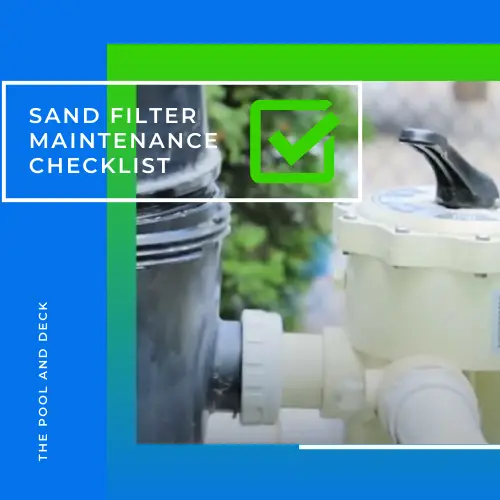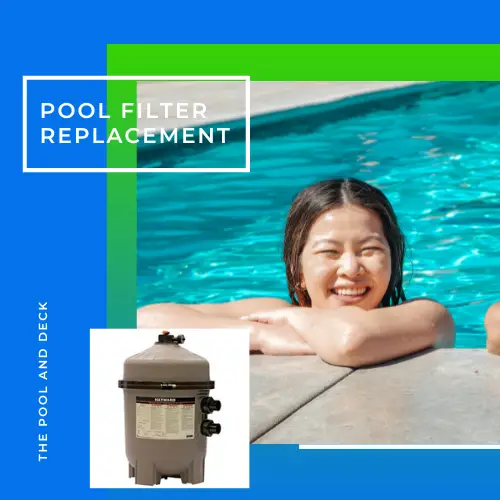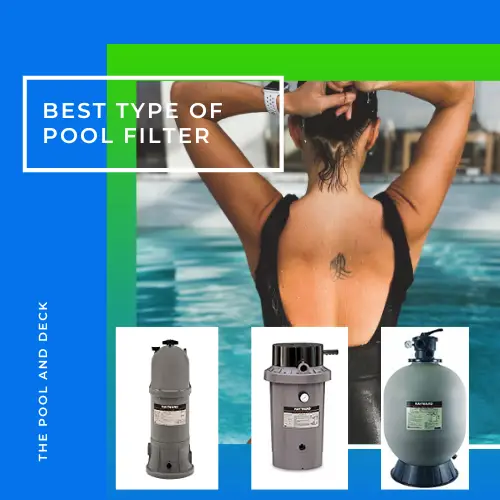Pool Alkalinity Too High: Cause, Effect & Solution
As an Amazon Associate, I earn from qualifying purchases.
Table of Contents
Is Your Pool Alkalinity Too High?
Is your pool alkalinity too high? Pool alkalinity needs to be within the recommended range.
The recommended range for pool alkalinity (aka Total Alkalinity) is 80 – 120 ppm.
KEY TAKEAWAYS
- Range: Ideal pool alkalinity range is 80-120 ppm.
- Cause: Overuse of chemicals, water source, and environmental factors.
- Effect: High alkalinity can cause cloudy water, scaling, and reduced chlorine effectiveness.
- Testing: Test weekly using test strips or liquid test kits.
- Solution: Lower alkalinity safely with muriatic acid or sodium bisulfate.
- Safety: Always wear protective gear and make gradual adjustments.
- Results: Balanced alkalinity stabilizes pH, improves water clarity, and protects equipment.
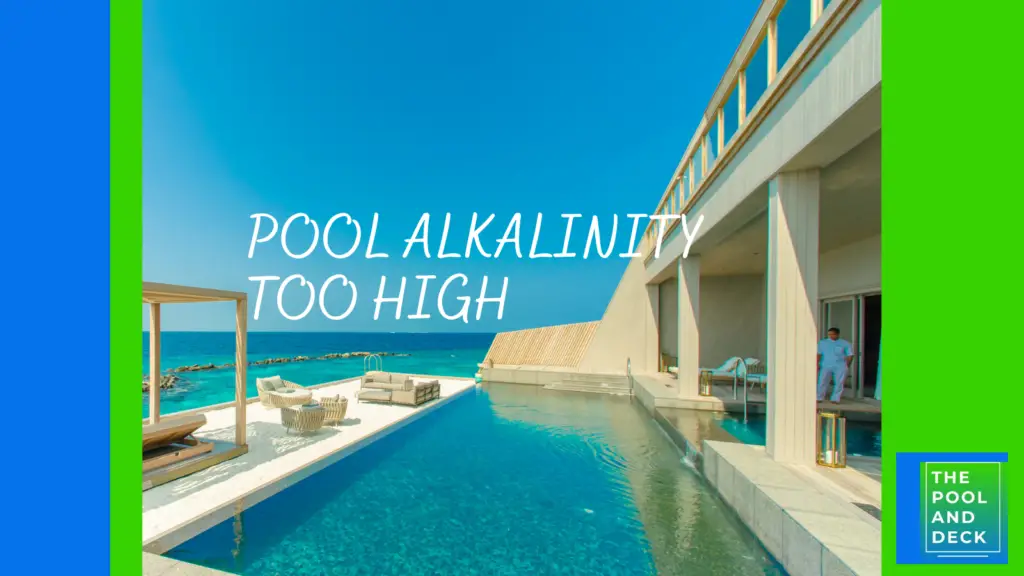
Both, pool alkalinity too high and pool alkalinity too low are not desirable conditions as they will have an adverse effect on the pH and pool water quality.
It would help if you fixed it as soon as possible. Maintaining balanced pool chemistry is essential for ensuring a safe and enjoyable swimming environment.
The chemical composition of pool water directly affects its clarity, cleanliness, and overall quality. Properly balanced pool chemistry prevents the growth of microscopic pathogens, protects pool equipment from corrosion, and safeguards the health of swimmers.
Pool alkalinity, referred to as Total Alkalinity (TA) is a key component of the 5 important pool water chemistry parameters; namely chlorine, CYA, pH, TA and calcium hardness.
Total Alkalinity (TA) acts as a buffer against pH fluctuations, helping to stabilize the water’s acidity. The effectiveness of chlorine, the primary disinfectant in pools, is a function of the pH level.
If you are a new pool owner, you may not be fully aware of the importance of having pool alkalinity too high. Truth be told, many experienced pool owners still get confused between alkalinity and pH.
New pool owners will benefit a lot by reading my earlier blog post, Pool Chemistry for Beginners: With 5 Super Helpful Cheat Sheets!
In this article, I will explain alkalinity and the importance of keeping pool alkalinity within the recommended range. The article will also answer the question, pool alkalinity too low: why and what to do?
What Is Pool Alkalinity (aka Total Alkalinity)?
The complete name for pool alkalinity is Total Alkalinity (TA). Total Alkalinity (TA) is the quantity of alkaline particles, mainly bicarbonates, in the water and is measured in parts per million (ppm).
Total Alkalinity (TA) acts as a buffer, stabilizing pool water pH. The effectiveness of chlorine and other sanitizers, as well as swimmer comfort is a function of the pH level and indirectly the TA level.
Since, Total Alkalinity acts as a buffer, helping to stabilize and prevent rapid changes in pH levels, TA is, in a way, a measure of the ability of pool water to resist changes in pH.
Maintaining pool alkalinity level within the recommended range prevents rapid pH fluctuations that can lead to corrosive or scale-forming conditions. The recommended range for Total Alkalinity (TA) is 80 – 120 ppm.
Consider pool alkalinity as being too high if TA exceeds 150 ppm.
What Causes High Total Alkalinity in a Swimming Pool?

High total alkalinity in a swimming pool is typically a result of chemical imbalances and the introduction of certain chemicals into the pool water.
Chemical Additives:
The use of certain pool chemicals can raise pool alkalinity beyond recommended levels. For instance, adding sodium bicarbonate (baking soda) or soda ash to adjust pH levels will increase total alkalinity.
Similarly, chlorine products, particularly stabilized forms like Trichlor can also contribute to higher alkalinity levels due to their buffering properties against acidity.
Overuse or improper use of alkaline-based pool chemicals, such as sanitizers or pH adjusters, can also lead to unintended spikes in alkalinity.
Water Source:
Filling a pool with water that has naturally high alkalinity, such as spring water containing elevated levels of bicarbonates and carbonates, can lead to increased total alkalinity in the pool.
Environmental Factors:
Evaporation can concentrate minerals in the water, including calcium carbonate, which raises alkalinity.
Carbonate-rich rainwater can increase pool alkalinity over time. Dust, leaves, and other airborne particles may carry alkaline substances, contributing to alkalinity imbalances.
Contaminants such as lotions, sweat, and organic matter introduced by swimmers can also affect the chemical balance and contribute to higher pool alkalinity.
Pool Maintenance Practices:
Regular maintenance practices like shocking the pool (especially with alkaline shock products) can temporarily spike both pH and alkalinity levels. If not monitored closely, these spikes can lead to persistent high alkalinity.
What is the Effect if Pool Alkalinity is Too High?
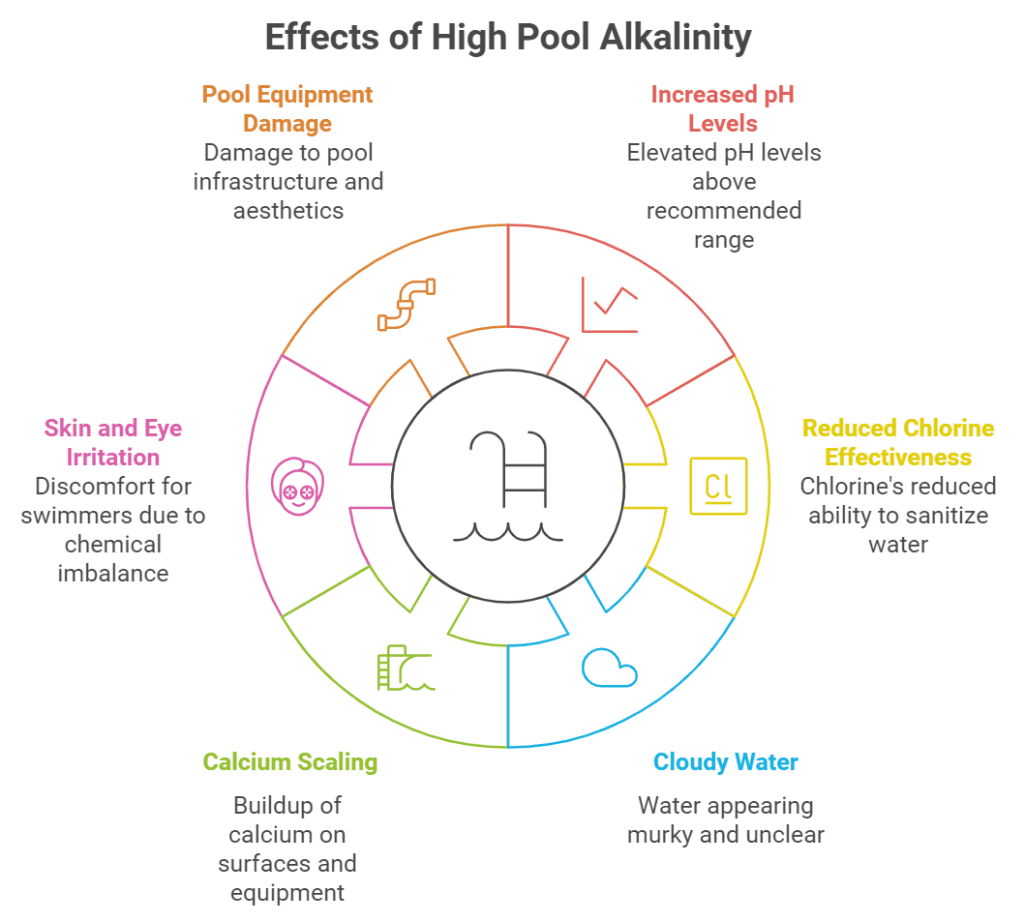
High Total Alkalinity can have detrimental effects on pool chemistry, equipment, and swimmers alike:
Increased pH Levels:
Pool alkalinity is a pH buffer. When total alkalinity is high it results in elevated pH levels, above the recommended range (7.2 to 7.8). A high pH results in most of the complications described below.
Reduced Chlorine Effectiveness:
When pH levels are too high, chlorine becomes less effective as a sanitizer. Insufficient disinfection of the pool water, increases the risk of algae growth and bacteria proliferation.
Cloudy Water:
Elevated alkalinity can contribute to cloudy water, which is often a sign of imbalanced chemistry. Cloudiness can arise from the precipitation of calcium and other minerals when the pH rises too high.
Calcium Scaling:
High alkalinity usually leads to calcium buildup on pool surfaces and equipment, resulting in scaling. This not only affects aesthetics but can also clog filters and reduce circulation efficiency, putting additional strain on the pool’s circulation system.
Skin and Eye Irritation:
Swimmers may experience discomfort such as itchy skin or burning eyes when swimming in water with high pH and alkalinity levels. These conditions arise from the chemical imbalance affecting swimmer comfort.
Pool Equipment Damage
When pool alkalinity is too high, you will notice scale deposits formation on pool walls, ladders, plumbing, pumps and filters. The deposits may result in the pump being required to work harder to maintain the desired water flow.
Equipment such as pool liners, ladders, etc will look prematurely old and reduce the visual appeal of your pool.
How do you Test Swimming Pool Alkalinity?
You can test the total alkalinity of your swimming pool by either using a Test Strip (convenient but less accurate) or a Liquid Test Kit (more accurate).
Test Strips:
How to Use: Dip a test strip into the pool water for a few seconds, then remove it and wait for the colors to develop.
Reading Results: Compare the resulting colors on the strip to the color chart provided with the strips. This method is quick and convenient, making it ideal for regular checks.
Liquid Test Kits:
How to Use: Collect a sample of pool water in a test tube. Add specific drops of reagents as instructed.
Reading Results: Observe the color changes in the sample. The intensity of these colors will indicate the alkalinity level. For total alkalinity, you may need to use additional reagents that specifically react to alkalinity.
For an even more sophisticated method use the one below.
Taylor Test Kit Method:
How to Use: Fill a comparator with 25 mL of pool water. Add two drops of R-0007 (thiosulfate) and swirl.
Then add five drops of R-0008 (total alkalinity indicator), which will turn the solution green. Finally, add R-0009 (sulfuric acid) drop by drop until the solution turns red, counting the drops.
Calculating Alkalinity: Multiply the number of drops used by 10 to determine total alkalinity in parts per million (ppm). The ideal range is typically between 80-120 ppm.
Recommended Chemical Test Kit
Taylor K-2005 Complete DPD 9-in-1 Test Kit
Tests for free & total chlorine, bromine, pH, total alkalinity, total hardness, and cyanuric acid (CYA) levels.
When to Test Pool Alkalinity
Test your pool’s alkalinity regularly, ideally at least once a week, or more frequently under the following conditions:
- After heavy pool usage
- Following significant rainfall
- When adding new water to the pool
- Before or after chemical treatments, such as algae treatments
How to Lower Alkalinity in a Pool?
Two chemicals can be used to reduce pool alkalinity. Muriatic Acid acts fast but needs careful handling. Sodium Bisulfate works fine too and is safer.
Using Muriatic Acid
Muriatic acid is a strong acid that is effective at lowering alkalinity. To use muriatic acid safely, follow these steps:
Materials Needed
- Muriatic acid
- Protective gear (gloves, goggles, and an acid-resistant apron)
- A plastic acid-resistant bucket
- Water for dilution
- Pool test kit
Steps to Follow
- Test the Water:
Before adding any chemicals, test your pool water to determine the current alkalinity and pH levels. This way you will know how much muriatic acid is needed.
- Calculate the Amount of Muriatic Acid:
A general guideline is that 25 ounces of muriatic acid can lower the alkalinity by about 10 ppm in a 10,000-gallon pool. Adjust based on your pool size and initial alkalinity level.
You can also use my Free Muriatic Acid Pool Calculator!
- Prepare the Dilution:
In a plastic bucket, add water first (at least half full) and then slowly pour in the muriatic acid. Always add acid to water, not the other way around, to prevent splashing and exothermic reactions.
- Add the Acid to the Pool:
With the pool pump running, slowly pour the diluted muriatic acid into the deep end of the pool while walking around its perimeter. This ensures even distribution and minimizes the risk of damaging surfaces.
- Allow for Circulation:
Let the pool pump run for at least 30 minutes to circulate the acid thoroughly throughout the pool water. Set the multi-port valve to “circulate” during this time.
- Re-Test pH and TA:
Re-test your pool water for pH and alkalinity levels after 4-6 hours.
- Repeat as Necessary:
If alkalinity is still too high after the first treatment, repeat the process in smaller increments until you reach the desired level.
Safety Precautions
- Always wear protective gear when handling muriatic acid to prevent skin burns or eye damage.
- Work in a well-ventilated area to avoid inhaling fumes.
- If any acid spills occur, neutralize with water immediately.
Pro Tip: Avoid adding too much muriatic acid at once; making gradual adjustments is better.
Recommended Muriatic Acid
Acid Blue Muriatic Acid by CPDI
Vapor Reduction Technology reduces up to 90% of harmful vapors compared to standard muriatic acid.
Using Sodium Bisulfate
Sodium bisulfate, also known as dry acid, is another effective way to lower pool alkalinity.
Materials Needed
- Sodium bisulfate (dry acid) – generally sold as a pH reducer or pH decreaser
- Protective gear (gloves and goggles)
- A plastic bucket (for mixing)
- Water for dilution
- Pool test kit
Steps to Follow
- Test the Water:
Start by testing your pool water to determine the current levels of total alkalinity and pH. This will help you understand how much sodium bisulfate you need to add.
- Calculate the Required Amount:
Check the instruction labels on the back of the pouch to determine the necessary dosage depending on pool volume (gallons) and pH level from step 1.
- Prepare the Solution:
In a plastic bucket, mix the sodium bisulfate with water. Always add the dry acid to water, not the other way around, to prevent splashing and ensure safe handling.
- Add Sodium Bisulfate to the Pool:
With the pool pump running, pour the prepared solution into the pool’s deep end in one concentrated spot. This method creates a “column effect,” allowing for a more effective alkalinity reduction without drastically affecting pH levels immediately.
- Allow for Circulation:
Let the pool pump run for at least 4-6 hours to ensure thorough mixing and distribution of the sodium bisulfate throughout the pool water.
- Re-Test Water Chemistry:
After circulation, re-test your pool water for both alkalinity and pH levels. This will help you determine if further adjustments are necessary.
- Repeat as Necessary:
If alkalinity is still too high after the first treatment, repeat the process in smaller increments until you reach the desired level.
Ways to Lower Pool Alkalinity Without Chemicals
Lowering pool alkalinity without using chemicals can be challenging, but can be done if the reduction requirement is not too high.
While these methods can help manage alkalinity levels, they may not produce immediate results like chemical treatments would.
Here are some methods to consider:
Aeration:
How It Works: Aeration increases the water’s exposure to air, allowing carbon dioxide (CO2) to escape.
Implementation: Use pool jets or fountains to create surface agitation. Directing the return jets towards the surface will enhance aeration. Running a pool vacuum or using a surface skimmer can also promote aeration.
Water Replacement:
How It Works: If your source water has lower alkalinity, partially replacing pool water can dilute the overall alkalinity.
Implementation: Drain a portion of the pool (about 10-20%) and refill it with fresh water. This method is only effective if your fill water has lower alkalinity levels than your pool.
Natural Materials:
How It Works: Adding natural materials such as peat moss or driftwood can absorb alkaline elements over time.
Implementation: Place these materials in mesh bags and submerge them in the pool. This method may take longer and is not precise but can result in gradual alkalinity reduction.
Increase Water Circulation:
How It Works: Improving circulation can help distribute existing chemicals more evenly and promote natural processes that may stabilize or lower alkalinity.
Implementation: Ensure that your pool pump and filtration system are operating efficiently. Regularly clean filters and check for any blockages in the plumbing.
Frequently Asked Questions (FAQs)
How does rainwater affect pool alkalinity and pH levels?
Rainwater often has alkaline chemicals dissolved in it. Further, rainwater also dilutes the pool water and changes the pool water’s chemical balance.
What is the difference between total alkalinity and pH?
Alkalinity stabilizes pH, acting as a buffer, while pH measures how acidic or basic the water is.
Can pool alkalinity be too low, and what happens if it is?
Low alkalinity can cause pH fluctuations, leading to corrosion of pool surfaces and equipment.
Do temperature changes affect pool alkalinity and pH levels?
Temperature changes affect the rate of chemical reactions within the pool. Moreover, higher temperatures increase evaporation, resulting in a higher concentration of dissolved minerals and indirectly affecting alkalinity.
Thank you very much for reading the post. I do hope you found it informative and helpful.





